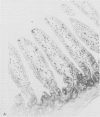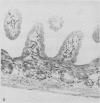Abstract
The current studies were performed to determine the influence of malnutrition alone or in combination with endotoxemia in promoting bacterial translocation from the gastrointestinal tract. Bacterial translocation did not occur in control, starved (up to 72 hours), or protein-malnourished (up to 21 days) mice not receiving endotoxin. Bacterial translocation to the mesenteric lymph nodes (MLNs) occurred in 80% of control mice 24 hours after receiving endotoxin (p less than 0.01). However, the combination of malnutrition plus endotoxin was associated with a higher incidence of translocation to the systemic organs (p less than 0.01), and higher numbers of bacteria per organ (p less than 0.01), than was seen in normally nourished mice receiving endotoxin. Additionally, mice that were protein malnourished were more susceptible to the lethal effects of endotoxin than were control animals, and the mortality rate was directly related to the degree of malnutrition (R2 = 0.93) (p less than 0.05). Histologically, endotoxin in combination with protein malnutrition resulted in mechanical damage to the gut mucosal barrier to bacteria. Thus, in the mice that were protein malnourished the spread of bacteria from the gut could not be controlled nor could translocated bacteria be cleared as well as normally nourished mice receiving endotoxin. These results support the concept that under certain circumstances the gut may serve as a clinically important portal of entry for bacteria.
Full text
PDF









Images in this article
Selected References
These references are in PubMed. This may not be the complete list of references from this article.
- Berg R. D., Garlington A. W. Translocation of certain indigenous bacteria from the gastrointestinal tract to the mesenteric lymph nodes and other organs in a gnotobiotic mouse model. Infect Immun. 1979 Feb;23(2):403–411. doi: 10.1128/iai.23.2.403-411.1979. [DOI] [PMC free article] [PubMed] [Google Scholar]
- Berg R. D. Inhibition of Escherichia coli translocation from the gastrointestinal tract by normal cecal flora in gnotobiotic or antibiotic-decontaminated mice. Infect Immun. 1980 Sep;29(3):1073–1081. doi: 10.1128/iai.29.3.1073-1081.1980. [DOI] [PMC free article] [PubMed] [Google Scholar]
- Bodey G. P. Antibiotic prophylaxis in cancer patients: regimens of oral, nonabsorbable antibiotics for prevention of infection during induction of remission. Rev Infect Dis. 1981 Nov-Dec;3 Suppl:S259–S268. [PubMed] [Google Scholar]
- Caridis D. T., Reinhold R. B., Woodruff P. W., Fine J. Endotoxaemia in man. Lancet. 1972 Jun 24;1(7765):1381–1385. doi: 10.1016/s0140-6736(72)91108-7. [DOI] [PubMed] [Google Scholar]
- Chandra R. K. Nutrition, immunity, and infection: present knowledge and future directions. Lancet. 1983 Mar 26;1(8326 Pt 1):688–691. doi: 10.1016/s0140-6736(83)91980-3. [DOI] [PubMed] [Google Scholar]
- Cuevas P., Ishiyama M., Koizumi S., Woodruff P., Kaufman A., Fine J. Role of endotoxemia of intestinal origin in early death from large burns. Surg Gynecol Obstet. 1974 May;138(5):725–730. [PubMed] [Google Scholar]
- Deitch E. A., Maejima K., Berg R. Effect of oral antibiotics and bacterial overgrowth on the translocation of the GI tract microflora in burned rats. J Trauma. 1985 May;25(5):385–392. doi: 10.1097/00005373-198505000-00002. [DOI] [PubMed] [Google Scholar]
- Deitch E. A., Winterton J., Berg R. Thermal injury promotes bacterial translocation from the gastrointestinal tract in mice with impaired T-cell-mediated immunity. Arch Surg. 1986 Jan;121(1):97–101. doi: 10.1001/archsurg.1986.01400010111015. [DOI] [PubMed] [Google Scholar]
- Gracey M., Suharjono, Sunoto, Stone D. E. Microbial contamination of the gut: another feature of malnutrition. Am J Clin Nutr. 1973 Nov;26(11):1170–1174. doi: 10.1093/ajcn/26.11.1170. [DOI] [PubMed] [Google Scholar]
- Gurwith M. J., Brunton J. L., Lank B. A., Harding G. K., Ronald A. R. A prospective controlled investigation of prophylactic trimethoprim/sulfamethoxazole in hospitalized granulocytopenic patients. Am J Med. 1979 Feb;66(2):248–256. doi: 10.1016/0002-9343(79)90539-4. [DOI] [PubMed] [Google Scholar]
- Johnson L. R., Copeland E. M., Dudrick S. J., Lichtenberger L. M., Castro G. A. Structural and hormonal alterations in the gastrointestinal tract of parenterally fed rats. Gastroenterology. 1975 May;68(5 Pt 1):1177–1183. [PubMed] [Google Scholar]
- Jones R. J., Roe E. A. Measurement of endotoxins with the limulus test in burned patients. J Hyg (Lond) 1979 Aug;83(1):151–156. doi: 10.1017/s0022172400025924. [DOI] [PMC free article] [PubMed] [Google Scholar]
- Manship L., McMillin R. D., Brown J. J. The influence of sepsis and multisystem and organ failure on mortality in the surgical intensive care unit. Am Surg. 1984 Feb;50(2):94–101. [PubMed] [Google Scholar]
- McDermott M. R., Mark D. A., Befus A. D., Baliga B. S., Suskind R. M., Bienenstock J. Impaired intestinal localization of mesenteric lymphoblasts associated with vitamin A deficiency and protein-calorie malnutrition. Immunology. 1982 Jan;45(1):1–5. [PMC free article] [PubMed] [Google Scholar]
- Morehouse J. L., Specian R. D., Stewart J. J., Berg R. D. Translocation of indigenous bacteria from the gastrointestinal tract of mice after oral ricinoleic acid treatment. Gastroenterology. 1986 Sep;91(3):673–682. doi: 10.1016/0016-5085(86)90638-4. [DOI] [PubMed] [Google Scholar]
- Morrison D. C., Ryan J. L. Bacterial endotoxins and host immune responses. Adv Immunol. 1979;28:293–450. doi: 10.1016/s0065-2776(08)60802-0. [DOI] [PubMed] [Google Scholar]
- Ninnemann J. L., Stockland A. E., Condie J. T. Induction of prostaglandin synthesis-dependent suppressor cells with endotoxin: occurrence in patients with thermal injuries. J Clin Immunol. 1983 Apr;3(2):142–150. doi: 10.1007/BF00915485. [DOI] [PubMed] [Google Scholar]
- Nolan J. P., Hare D. K., McDevitt J. J., Ali M. V. In vitro studies of intestinal endotoxin absorption. I. Kinetics of absorption in the isolated everted gut sac. Gastroenterology. 1977 Mar;72(3):434–439. [PubMed] [Google Scholar]
- RAVIN H. A., FINE J. Biological implications of intestinal endotoxins. Fed Proc. 1962 Jan-Feb;21:65–68. [PubMed] [Google Scholar]
- Syme G. The effect of protein-deficient isoenergetic diets on the growth of rat jejunal mucosa. Br J Nutr. 1982 Jul;48(1):25–36. doi: 10.1079/bjn19820084. [DOI] [PubMed] [Google Scholar]
- Tannock G. W., Savage D. C. Influences of dietary and environmental stress on microbial populations in the murine gastrointestinal tract. Infect Immun. 1974 Mar;9(3):591–598. doi: 10.1128/iai.9.3.591-598.1974. [DOI] [PMC free article] [PubMed] [Google Scholar]
- Wade J. C., Schimpff S. C., Hargadon M. T., Fortner C. L., Young V. M., Wiernik P. H. A comparison of trimethoprim-sulfamethoxazole plus nystatin with gentamicin plus nystatin in the prevention of infections in acute leukemia. N Engl J Med. 1981 Apr 30;304(18):1057–1062. doi: 10.1056/NEJM198104303041801. [DOI] [PubMed] [Google Scholar]
- Walker R. I., Porvaznik M. J. Disruption of the permeability barrier (zonula occludens) between intestinal epithelial cells by lethal doses of endotoxin. Infect Immun. 1978 Aug;21(2):655–658. doi: 10.1128/iai.21.2.655-658.1978. [DOI] [PMC free article] [PubMed] [Google Scholar]
- Walker R. I. The contribution of intestinal endotoxin to mortality in hosts with compromised resistance: a review. Exp Hematol. 1978 Feb;6(2):172–184. [PubMed] [Google Scholar]
- de Vries-Hospers H. G., Sleijfer D. T., Mulder N. H., van der Waaij D., Neiweg H. O., van Saene H. K. Bacteriological aspects of selective decontamination of the digestive tract as a method of infection prevention in granulocytopenic patients. Antimicrob Agents Chemother. 1981 May;19(5):813–820. doi: 10.1128/aac.19.5.813. [DOI] [PMC free article] [PubMed] [Google Scholar]






